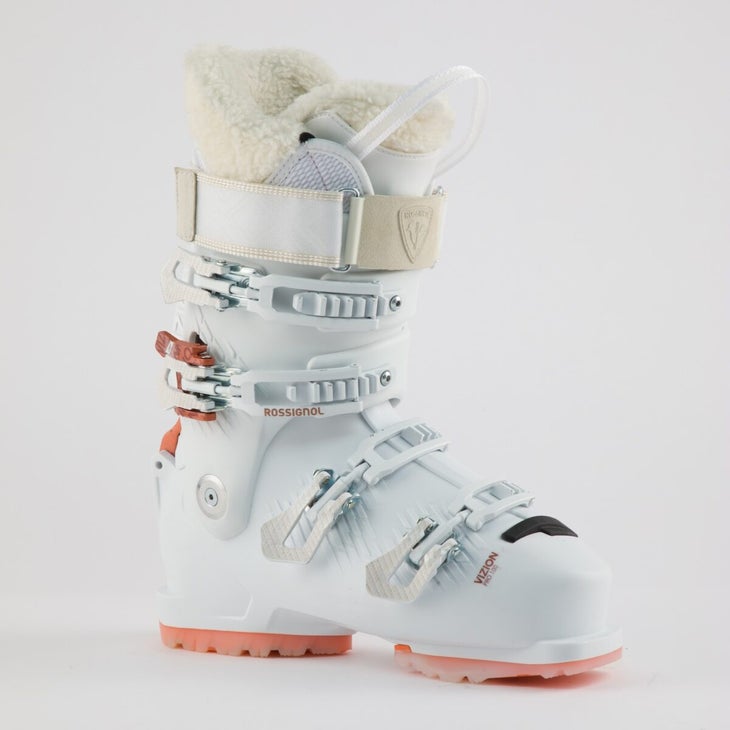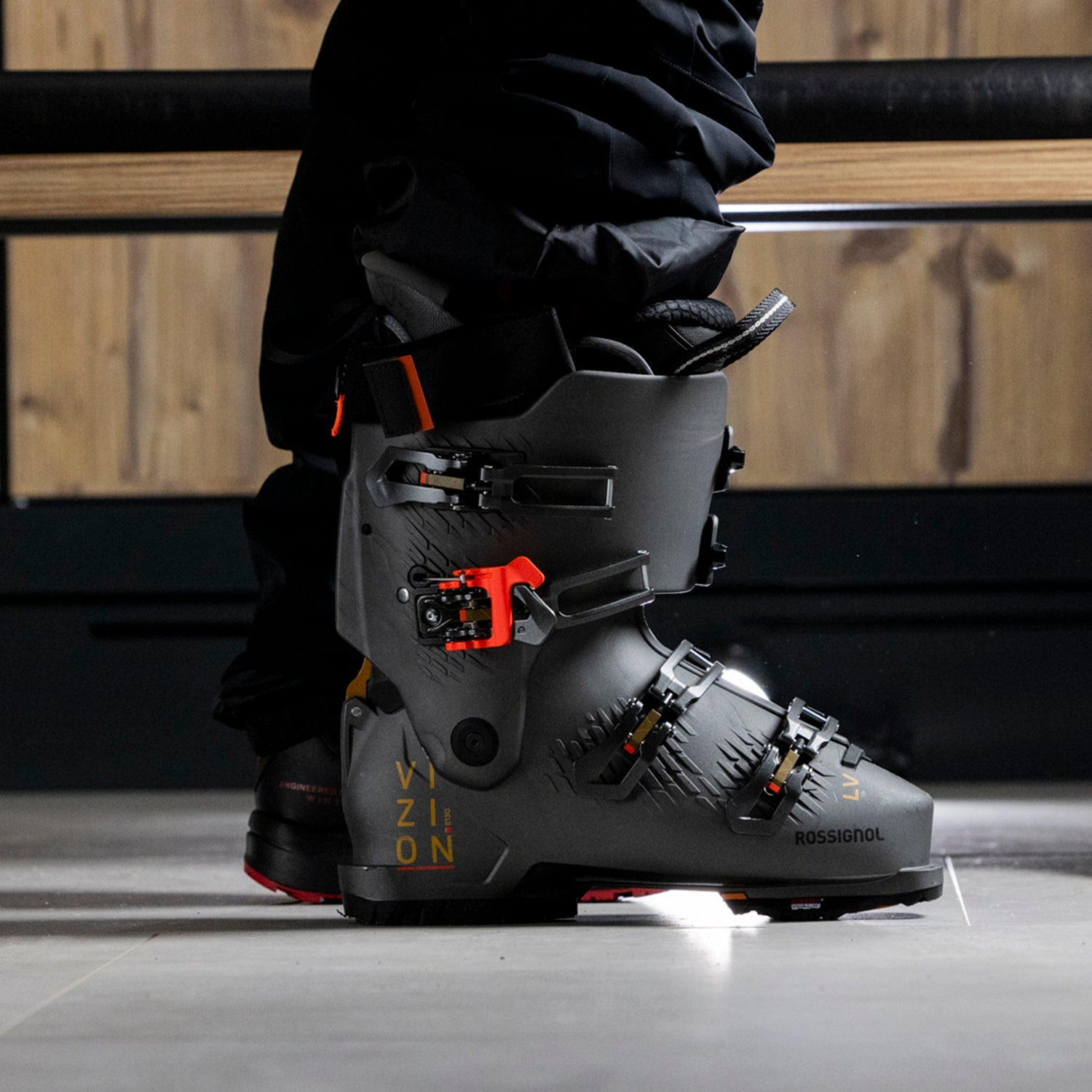In early December of 2023, SKI and ║┌┴¤│ď╣¤═° editors sat around a conference table in RossignolÔÇÖs pop-up showroom at the Gravity Haus in Vail, Colorado, staring at a powerpoint presentation. Projected onto the wall were illustrations of a new ski boot the brand would be releasing in the fall of 2024ÔÇöa boot, the brand claimed, that would address skiersÔÇÖ biggest issue with ski boots: getting them on and off.
We sat and looked at slide after slide highlighting the VizionÔÇÖs key design and technology elements: a traditional four-buckle overlap boot; a steel spine; and something Rossi is calling ÔÇťSpine Link Mechanism,ÔÇŁ an element that allows the back of the boot cuff to hinge backwards to widen the cuff opening, then lock back into an upright position. Each slide was bedazzled with phrases like ÔÇťeasier entry,ÔÇŁ ÔÇťoptimal performance,ÔÇŁ ÔÇťpowerful flex.ÔÇŁ
It all looked and sounded good, but as I sat in that darkened conference room, it was hard for me to get excited. Call me a jaded gear editor, but the Vizion boot just looked like a new hybrid of an alpine boot and a backcountry boot, with a fancier hike mode mechanism that Rossignol was putting a new spin on to speak to desperate ski boot customers: Not only is this boot easier to walk in, itÔÇÖs a breeze to get on!
Then Jake Stevens, RossignolÔÇÖs North American alpine and bike category manager, handed me a real-life Vizion boot to try on. With the flip of a buckle, I disengaged the bootÔÇÖs Spine Link Mechanism, placed the boot on the floor, stood up, and stepped into the bootÔÇöhandsfree.
Color me impressed. But what really blew me away was reengaging the spine and buckling up; once locked in, the Vizion felt like a true alpine boot with a predictable flex. IÔÇÖd expected it to feel like a backcountry boot, with a weird, hingey flex that comes from a walk-ride mechanism. But I was firmly locked into the 100-flex Vizion model on my foot, and when I drove my knee forward, the cuff moved with my shin exactly as a traditional four-buckle, overlap shell should.
Read more:
ThatÔÇÖs what sets the Vizion apart. Ski boots that are designed to be more comfortable and easier to get on are not newÔÇöNordica brought back the rear-entry design with its (hands-free) boot, and plenty of brands make four-buckle overlap boots with a walk-mode to not only make it easier for skiers to walk in boots, but easier to get them on. But most of these ski boots compromise on performance in the name of comfort.
Rossignol claims that the new Vizion is not just a ÔÇťcomfortÔÇŁ boot aimed at the recreational skier. The Vizion lineÔÇöwhich encompasses 10 models across the unisex and womenÔÇÖs rangeÔÇöincludes everything from a 130-flex low-volume offering down to an 80-flex high-volume option, making it for every type of skier.
Read more:
According to Rossignol, its goal in creating the Vizion was to keep the performance of a traditional overlap boot (i.e. consistent boot flex, feel, and function), but make it the easiest boot on the market to slip on and off the foot, solving the biggest pain point for skiers worldwide.
Mission accomplished? I havenÔÇÖt had a chance to ski in the new Rossignol Vizion boot yet, though IÔÇÖm definitely intrigued. But IÔÇÖm no ski boot expert, so to gauge how legit the concept of this boot actually is, I turned to professional bootfitter Sam Tischendorf to get her take.
Sidelined by a knee injury last season, she also hasnÔÇÖt had a chance to ski the boot yet, but sheÔÇÖs spent a good amount of time inspecting it at trade shows and chatting about it with her Masterfit colleagues (who have skied in it). From the sounds of it, bootfitters are bought into RossignolÔÇÖs new Vizion. Considering how can be, thatÔÇÖs saying something.
The following interview has been edited for length and clarity. Look for SKIÔÇśs official review of the new Rossignol Vizion boot in the fall.┬á
Rossignol Vizion Preview with Professional Bootfitter Sam Tischendorf
JW: Sam, in your professional opinion, is the hype about this boot real? 
ST: I think so. This is not just fairy dust sprinkled on a boot. ItÔÇÖs a legitimate solution for getting your foot into a ski boot. I was still hopping along on my bad knee and apprehensive about wrestling with a boot to get it on, but I was able to stand on my good leg and slide into the boot on my bad leg, hands-free and without a grimace.
Bootfitters seemed skeptical about BOA when it was introducedÔÇösome still are. Do you get the sense that theyÔÇÖre more on board with the idea of the Vizion boot?
ThereÔÇÖs more excitement with this Vizion boot compared with BOA in terms of actual technology. No offense to BOA, but all they did was put a new buckle on a boot thatÔÇÖs meant to wrap the foot a little better. Most brands are using BOA but doing so slightly differently, and across the board, I donÔÇÖt think itÔÇÖs that impactful of a difference.
The spine mechanism on this boot seems similar to a walk mechanism on a backcountry boot. Is it basically the same?
The technology Rossignol developed for this boot is unique. You open this latch on the lower buckle of the cuff that releases the spine of the boot, opening the cuff wider than any hike-and-ride boot does. You can then literally stand and slide into the boot hands-free. And the way Rossignol designed this boot, the buckles on the front wrapping section donÔÇÖt get in the way.
As bootfitters, a solution we often use for folks who really struggle to get into their ski boots is a hike-and-ride boot, so we can open that walk-mode feature to help people slide their foot in. But a walk-mode feature is minimal compared to what the Vizion boot actually does.
RossignolÔÇÖs Spine Link Mechanism is primarily designed to help you get into the boot. But once you buckle up, you donÔÇÖt have a massive walk-mode in the Vizion. This is not a super easy boot to walk around in necessarily, and itÔÇÖs not designed to be used for uphill, which is why it doesnÔÇÖt have tech inserts. ItÔÇÖs really an alpine boot with a mechanism built in to help you effortlessly slide into the boot.
How is the Vizion different from the rear-entry boots of yore? Those boots were all designed to address the ease of entry issue, but thereÔÇÖs a reason we donÔÇÖt see those boots on shop shelves anymore.┬á
The problem with rear-entry boots was that they just didnÔÇÖt ski well. When you look at the Vizion when itÔÇÖs closed up, it looks like a traditional four-buckle overlap boot. And by all accounts, thatÔÇÖs how it skis.
When I was walking around and flexing it, it felt like I was just in a regular four-buckle performance alpine boot. There was no feeling of ÔÇťoh, this feels dodgy,ÔÇŁ or ÔÇťthey missed this feature because they focused on the ease of entry component.ÔÇŁ When youÔÇÖve got the boot on, it feels like a boot you can really ski in.
And from everyone I talked to who was at the AmericaÔÇÖs Best Bootfitters boot test this spring, it sounds like itÔÇÖs a really strong-skiing boot.
Who is the target market for the Vizion? Is it more casual recreational skiers who just donÔÇÖt want to deal with the inconvenience of stiff boots?
ItÔÇÖs for everyone. If weÔÇÖre being honest, we all wrestle with putting our ski boots on and taking them off. Within the bootfitting community, itÔÇÖs the constant question on the table: How do we make a boot easier to put on and take off. It does not matter the skierÔÇöall of us want and need more of that convenience.
So from a feature standpoint, we can sell this boot to a super casual, recreational skier who wants a 100 flex boot thatÔÇÖs comfortable and easy to get on. We can sell it to people who are a little less physically able to get into their ski boot, yet give them better performance than some of the rear-entry boots that are still floating around. But this boot is also for the expert skier who will love the boot from a performance standpointÔÇöhow it skis. They might be interested in the ease-of-entry feature, but theyÔÇÖre also interested in the performance side of it.
Related:
Can you still customize it like a regular boot?
ItÔÇÖs made like a regular Rossignol boot, so you can custom fit it like any other Rossignol boots. From stretching to padding to whatever customization you typically do to your boot, youÔÇÖre going to be able to do that to this boot, too.
Any early criticism or potential drawbacks to this boot?
My one complaint is that I think Rossignol missed the mark on the womenÔÇÖs Vizion boot in terms of aesthetics. ItÔÇÖs a really white boot with a plush, soft liner.┬á IÔÇÖm afraid it will give women the wrong visual of what this boot actually is. Some lady customers might like the look, but it might take a while for some women to step away from the frilly visual and focus on the legitimacy of the boot from a performance standpoint.

And like any ski boot,┬á Rossignol boots arenÔÇÖt the perfect fit for every customer. I personally think Rossi boots work best for more moderate foot typesÔÇösomeone who doesnÔÇÖt have a pencil foot but does have a little bit of a heel bone. IÔÇÖve found them to be fabulous for folks who have a higher instepÔÇöRossi boots tend to encapsulate that higher instep really well. They also tend to be good choices for skiers who are between two sizesÔÇöI find that Rossignol boots give you a few extra millimeters in length, so it can help with size differentiation.
But having the Vizion be available in so many different flex, last, and volume options definitely opens this boot up to a wider demographic.
Sam Tischendorf is one of the very few professional female ski bootfittersÔÇöor as she likes to say, professional feet ticklersÔÇöin the industry. She currently works at ┬áin Telluride, Colo., is a member of the┬á, and collaborates with Blizzard/Tecnica on the Women To Women gear project.
More On Ski Boots


